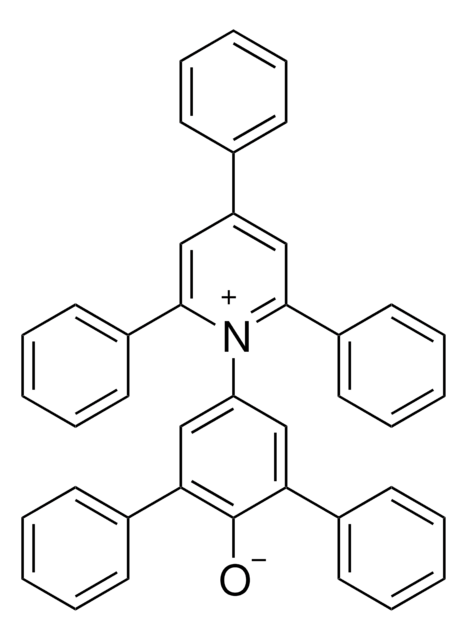Dye solar cells degrade from ultraviolet radiation. For this reason, the barrier may include UV stabilizers and/or UV absorbing luminescent chromophores (which emit at longer wavelengths) and antioxidants to protect and improve the effieciency of the cell.
703168
cis-Bis(isothiocyanato)(2,2′-bipyridyl-4,4′-dicarboxylato)(4,4′-di-nonyl-2′-bipyridyl)ruthenium(II)
95% (NMR)
Sinônimo(s):
Greatcell Solar®, Z-907 dye
About This Item
Produtos recomendados
Ensaio
95% (NMR)
Formulário
powder
composição
Dye content, ≥90%
pf
196 °C
λmax
531, 314, 295 nm (lit.)
cadeia de caracteres SMILES
S=C=N[Ru]N=C=S.OC(=O)c1ccnc(c1)-c2cc(ccn2)C(O)=O.CCCCCCCCCc3ccnc(c3)-c4cc(CCCCCCCCC)ccn4
InChI
1S/C28H44N2.C12H8N2O4.2CNS.Ru/c1-3-5-7-9-11-13-15-17-25-19-21-29-27(23-25)28-24-26(20-22-30-28)18-16-14-12-10-8-6-4-2;15-11(16)7-1-3-13-9(5-7)10-6-8(12(17)18)2-4-14-10;2*2-1-3;/h19-24H,3-18H2,1-2H3;1-6H,(H,15,16)(H,17,18);;;/q;;2*-1;+2
chave InChI
LALSZYPVVQFXIC-UHFFFAOYSA-N
Categorias relacionadas
Aplicação
Informações legais
Greatcell Solar is a registered trademark of Greatcell Solar Materials Pty Ltd.
Palavra indicadora
Warning
Frases de perigo
Declarações de precaução
Classificações de perigo
Eye Irrit. 2 - Skin Irrit. 2 - Skin Sens. 1 - STOT SE 3
Órgãos-alvo
Respiratory system
Código de classe de armazenamento
11 - Combustible Solids
Classe de risco de água (WGK)
WGK 3
Ponto de fulgor (°F)
Not applicable
Ponto de fulgor (°C)
Not applicable
Equipamento de proteção individual
dust mask type N95 (US), Eyeshields, Faceshields, Gloves
Escolha uma das versões mais recentes:
Já possui este produto?
Encontre a documentação dos produtos que você adquiriu recentemente na biblioteca de documentos.
Os clientes também visualizaram
Artigos
Dye solar cells (DSCs) are third generation solar cells with the promise of high efficiency combined with low production costs. While present day DSCs provide light-to-electricity conversion of up to 11%, significant further improvement is envisaged through optimized materials and novel cell and module architectures.
Dye-sensitized solar cells directly convert sunlight to electricity
Operation principle and market dominance of single crystalline silicon solar cells.
Dye-sensitized solar cells (DSCs) are 3rd generation solar cells combining the promise of high efficiency with low production costs.
-
What can cause degradation of the dye solar cell?
1 answer-
Helpful?
-
-
What is the Department of Transportation shipping information for this product?
1 answer-
Transportation information can be found in Section 14 of the product's (M)SDS.To access the shipping information for this material, use the link on the product detail page for the product.
Helpful?
-
-
What are the advantages of dye solar cells?
1 answer-
Dye solar cells (DSCs) are 3rd generation solar cells with the promise of high efficiency combined with low production costs.
Helpful?
-
-
What are the disadvantages of dye solar cells?
1 answer-
The major disadvantage to the dye solar cell design is the use of a liquid electrolyte, which has temperature stability issues. The electrolyte can freeze at low temperatures and expand at higher temperatures. It the electrolytes freezes, power production would cease, and it could potentially lead to physical damage. If the liquid expands at higher temperatures, sealing the panels would be difficult.
Helpful?
-
Active Filters
Nossa equipe de cientistas tem experiência em todas as áreas de pesquisa, incluindo Life Sciences, ciência de materiais, síntese química, cromatografia, química analítica e muitas outras.
Entre em contato com a assistência técnica





2 ≥95%](/deepweb/assets/sigmaaldrich/product/structures/190/371/c5efe61d-383f-4364-90c6-1912d88674f3/640/c5efe61d-383f-4364-90c6-1912d88674f3.png)









